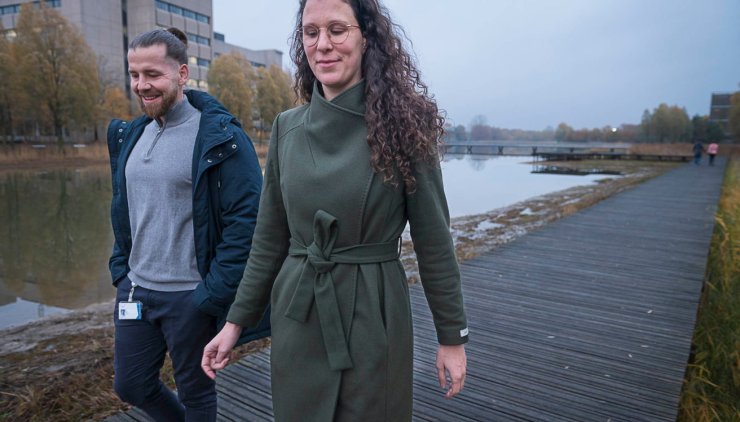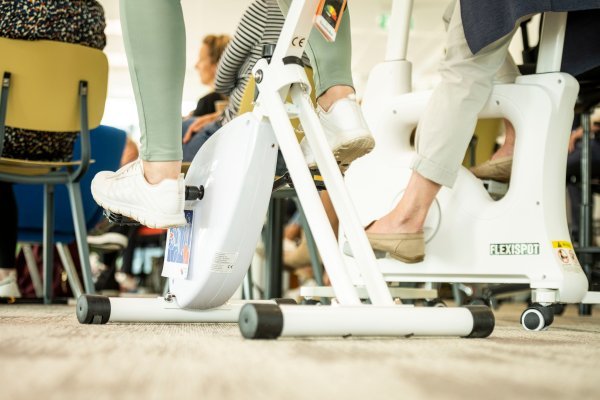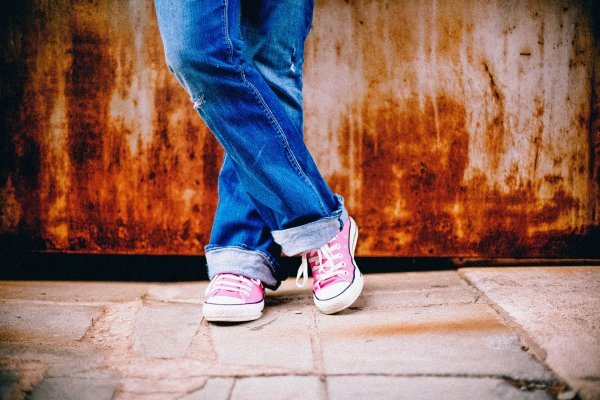-
19 december
This is what your future workplace will look like

Sensors in the ceiling, in the planters and in the desks. Various models of exercise bikes that fit precisely under a stand-up desk. Lighting that moves with the color of the light outside: whiter light in the morning and yellower light at the end of the day. Welcome to the Workplace Vitality Hub at High Tech Campus Eindhoven, where Fontys, together with other knowledge institutions, is investigating how workplaces can contribute to our fitness and vitality.
Too little exercise
Meet Frank Bauman and Ida Damen. Frank teaches behavior change, focused on exercise, at Fontys Sporthogeschool and is also a researcher at the lectorate Move To Be and program manager of Move To Health. Ida received her PhD from TU/e on research into employee vitality and the role technology plays in this. Like Frank, she is also a researcher at the lectorate Move To Be.

Together with Frank, Ida focuses on how movement can be better integrated into the working day. 'Many people move little during a working day. That is not beneficial to your health. Physical inactivity is the fourth leading cause of death in the world, according to the World Health Organization. We are investigating how to add movement to a workday, because it has many benefits.'
Desk with fresh air
The Workplace Vitality Hub is a living lab where the (healthy) workplace of tomorrow is conceived and tested. Frank shows the desk(top) of the future. The temperature of the top is adjustable. Moreover, on the corner of the top are two blow-in points that - if you want - blow cool air. 'You may like a fresh workplace, but your colleague may like it a little warmer. In the office of the future, it's all possible.'
According to Ida, a workplace that you can adjust to your wishes can become crucial in the recruitment of new employees. 'Staff are scarce at the moment. Moreover, many people now work from home, while employers would like them to come to the office more often. A workplace that can be adjusted to your wishes and contributes to your vitality might well help attract new employees. And if they also help to keep those employees fit and prevent employees from dropping out, they're well worth the investment.'
Workwalk in your agenda
To entice employees to exercise more during their workday, Ida has developed a "workwalk," a working walk. Ida: 'Of course employees are free to go for a walk during their break, but why not integrate it into our working hours? You can combine working and walking very well. Walking meetings, for example. That works just fine. For example, a walking meeting often takes less time than a sitting meeting. Furthermore, it turns out that walking (together) promotes creativity and strengthens social cohesion.'

So why don't we do it more often? Frank: 'One reason is that walking during working hours feels like a break for many people.' Ida: 'When we try to get people to exercise more we often talk about the long-term health effects. Sometimes people feel that's too far ahead. However, exercise also has short-term positive effects such as increased productivity and creativity.'
So the challenge is to get the "workwalk" socially accepted. Ida: 'That's why I came up with the idea that you should be able to reserve a workwalk in your Outlook calendar, just like a regular meeting. Your colleagues then see that you are working, just outside. This gives the workwalk a bit of a formal character. We designed several walks with a length of about two kilometers.'
At first glance, this may seem quite odd, since, after all, people are free to walk that stretch on their own, without checking in. 'However, we think it can help if you give it a formal form. Take a pedometer. You don't need that to go for a walk either. Yet that app encourages quite a few people to exercise more.'
Walking shoes and rain jacket
Besides the booking system, the workwalk contains two more elements that distinguish it from 'just' any walk: physical lining of the route and meeting points. Ida: 'This basically gives a workwalk the same status as booking - for example - meeting room 3.01. And: the walkers have made an appointment. They know where to meet, that they better put on easy shoes and that they might need to bring a coat.'
Three workwalks have now been set out: at the High Tech Campus (three routes) and the TU site in Eindhoven and at the University of Tilburg (Warande). A fourth and fifth route, at the Philips head office in Amsterdam and the Fontys Sporthogeschool, are in the pipeline. Frank: "The ones at the Fontys locations are not only for employees, but also to go outside with students and give lectures partly outside. And the Fontys campus Rachelsmolen in Eindhoven we want to connect to the workwalk on the TU grounds.'
Ida and Frank provide 'walk workshops' with explanations. Want to know more?
